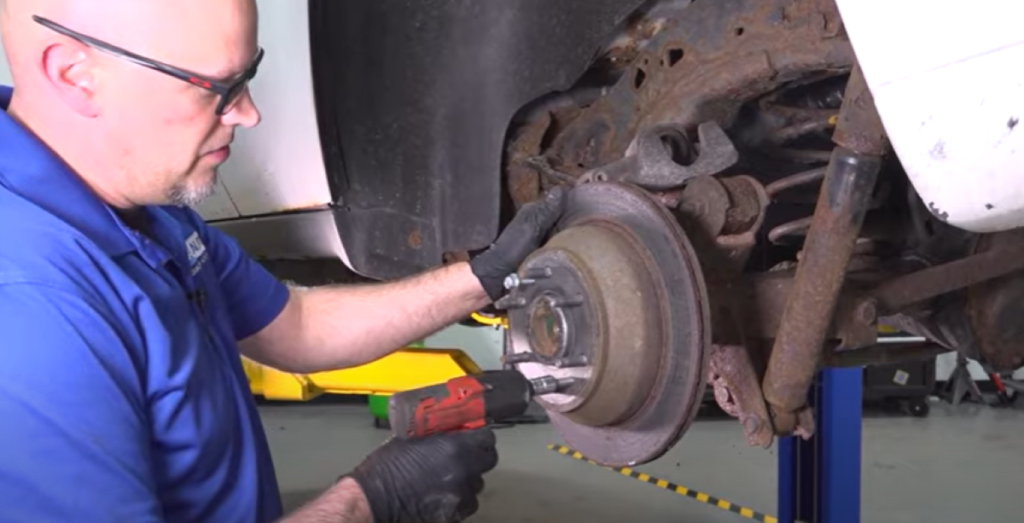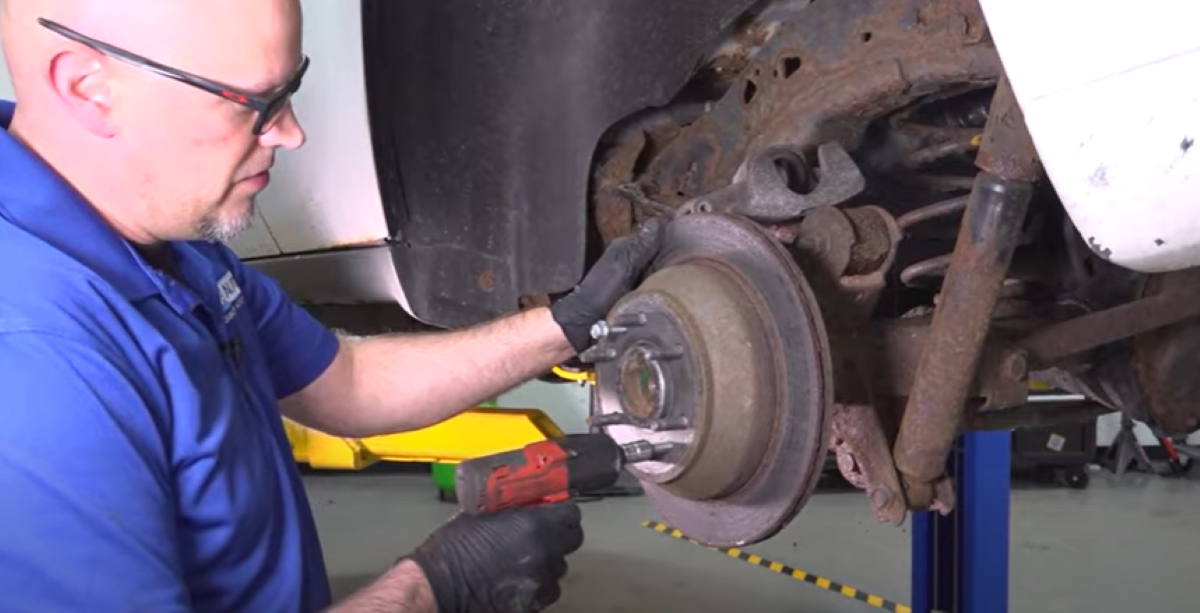If your car has brakes sticking while driving, there could be a problem with the brake caliper or brake caliper bracket, the brake pads, emergency brake parts or the brake cable. Find out how to tell if the emergency brake or other brake parts are causing your brakes to stick or bind with these tips.
How to Diagnose Brakes Sticking While Driving

Driving with binding or sticking brakes like ones in this article’s featured video can decrease your fuel mileage. The engine has to work harder to push vehicle and it’ll burn more fuel. If you notice binding in the rear, use these steps to tell if the problem is with the parking brake or the brakes.
Steps to diagnose brakes sticking while driving
- Raise the Vehicle, Have an Assistant Pump the Brake Pedal, and Look for Binding
Visually inspect for binding or sticking brakes by raising the vehicle with a jack and jack stands. Then have an assistant pump the brake pedal. Have them push down as hard as possible. Then have them try the parking brake a few times see if it binds up. - Lower the Vehicle to the Ground, Turn the Wheel, and See If One Wheel Binds More
Once you’ve tested the brakes and emergency brake for binding, lower the vehicle to the
ground to check the wheels. Try to turn the wheel with the brakes released. For the rear wheels, if one is binding up more than the other, then there’s likely a problem with the parking brake or brake cable. - Check the Brake Caliper for Sticking
Raise and secure the vehicle with a jack and jack stands. Remove the wheel to access the brake caliper. If possible, pry back the brake caliper piston with a screwdriver. You’ll know you have a problem if you can’t move the piston.
For a better inspection, remove the brake caliper and inspect it further. Check the dust boot for rips. Outside elements can work inside and bind it up.
You can also test the piston with a brake caliper compressing tool. Keep in mind the compressing tool has a mechanical advantage, and it can feel like the piston works better than it does. You might not notice a problem with the piston unless it’s frozen.
More on how to check a sticking brake caliper
- Check the Brake Line Hoses
If the caliper is binding, there could be an issue with the hose. Pressure could build up in the caliper but not release. If you’re compressing the caliper piston and it’s not moving, you can open up the bleeder screw to check the brake hoses.
If you’re able to open up bleeder screw and could compress the brake caliper piston into the caliper, then the hose has a blockage in it or somewhere down the brake line.
Steps on how to open a stuck bleeder screw
Pro Tip: We do not recommend pinching the brake line off if you’re removing the caliper and disconnecting the brake line. They’re hydraulic hoses, and pinching can collapse them and cause more damage. - Check the Brake Caliper Bracket
Check the slide pins in the brake caliper bracket that slide in and out. Inspect the boots around them for tearing or damage. Test how well the slide pins work. They should slide in and out easily.
When the brake caliper is compressed, it pulls the caliper toward the inside of the vehicle to apply the outer brake pad, and uses the pins to slide back and forth. If the pin is bound up like the one in our video at 3:45, then after the caliper is compressed it’ll be push on the brake pad, leaving it pressed snug against the brake rotor.
Clean the slides with brake parts cleaner and apply grease. Also clean the brake caliper bracket with brake parts cleaner and a wire brush. - Check the Brake Pads
Check the brake pads for corrosion. Excessive corrosion can bind them up and cause sticking while driving.
The brake pads should move freely in the caliper bracket and there should not be resistance. In our example, the pads are frozen in the brake caliper bracket. If they’re stuck pressed in, it will feel like you’re trying to drive with the brakes continuously applied. - Check the Parking Brake Shoes
Remove the brake rotor and look at the parking brake shoes. These shoes work when the parking brake is applied. Turning the parking brake on will pull on a parking brake cable attached to a lever that’s attached to the brake shoes. The shoes then push out on the inside of the brake drum and this stops your vehicle from rolling.
Check the thickness of the brake shoes. If they’re worn down to almost no shim material left, then they’ve been dragging or are worn out. - Check the Parking Brake Cable
The spring will bring the parking brake cable back to its resting position when the parking brake is released. The spring should be more open if the parking brake cable and lever is released. If the spring is still compressed with the cable released, then the issue lies with the cable. Inspect the brake cable for rust and corrosion, and look for damage like swelling. The bracket is rusty in our video, but it’s still not damaging the cable.
With the help of an assistant, you can inspect the junction where the cables come together. Have an assistant apply the parking brake. With the parking brake applied, look for binding. Then have them release it and confirm these parts are working. If one of the cables is not moving, then its frozen and causing sticking brakes.
- Check the Adjuster
The adjuster in our video at 7:00 is bound up on one side but moves on the other. The adjustor should not be bound up. Remove the adjustor and see if it unbinds. Try to soak it with rust penetrant to fix any sticking, or consider replacing it. We loosened it by placing it in a vice, applying rust penetrant and moving it with a pry bar. To clean the adjustor, take it apart and clean it with a wire brush. Before reinstalling, put a little grease on the end of the adjuster.
More on how to clean and adjust rear brakes
- After Replacing Any Parts, Bleed the Brakes If Needed
After replacing any parts, make sure the brake master cylinder has enough brake fluid. You’ll have a harder time bleeding the brakes with less fluid.
Then bleed the brakes if you removed the brake caliper and disconnected the brake lines.
More on how to bleed brakes
Shop Quality Auto Parts with Free Shipping

More Expert Tips
- How-to videos to help with car repairs
- What Is the Correct Order to Bleed Brakes? How to Bleed Brakes
- How to Bleed Brakes By Yourself
- Why Are My Brakes Sticking?
- Causes and Fixes of Pulsating Brakes
- Pontiac Vibe Problems: 2nd Generation (2009 to 2010)

